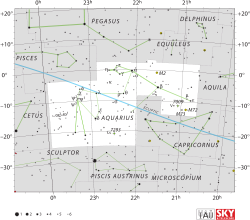Tau1 Aquarii
| Observation data Epoch J2000 Equinox J2000 | |
|---|---|
| Constellation | Aquarius |
| Right ascension | 22h 47m 42.76932s[1] |
| Declination | –14° 03′ 23.1409″[1] |
| Apparent magnitude (V) | +5.66[2] |
| Characteristics | |
| Spectral type | B9 V[3] |
| U−B color index | –0.25[4] |
| B−V color index | –0.05[4] |
| Astrometry | |
| Radial velocity (Rv) | +15[5] km/s |
| Proper motion (μ) | RA: +30.61[1] mas/yr Dec.: –9.23[1] mas/yr |
| Parallax (π) | 10.27 ± 0.46 mas[1] |
| Distance | 320 ± 10 ly (97 ± 4 pc) |
| Details | |
| Radius | 2.0[6] R☉ |
| Age | 100[7] Myr |
| Other designations | |
| Data sources: | |
| Hipparcos Catalogue, CCDM (2002), Bright Star Catalogue (5th rev. ed.) | |
Tau1 Aquarii (τ1 Aqr, τ1 Aquarii) is the Bayer designation for a star in the equatorial constellation of Aquarius. With an apparent visual magnitude of 5.66,[2] it is a faint naked eye that requires dark suburban skies for viewing. Parallax measurements made during the Hipparcos mission yield a distance estimate of roughly 320 light-years (98 parsecs) from Earth.[1]
τ1 Aquarii has a stellar classification of B9 V;[3] right along the borderline between a B- and A-type main sequence star. It is around 100[7] million years old and has twice the Sun's radius.[6] When examined in the infrared band, it displays an excess emission that is a characteristic of stars with an orbiting debris disk. Indeed, the model that best fits the data suggests there are two concentric circumstellar disks.[7]
References
- ^ a b c d e f van Leeuwen, F. (November 2007), "Validation of the new Hipparcos reduction", Astronomy and Astrophysics, 474 (2): 653–664, arXiv:0708.1752, Bibcode:2007A&A...474..653V, doi:10.1051/0004-6361:20078357.
- ^ a b Corben, P. M.; Stoy, R. H. (1968), "Photoelectric Magnitudes and Colours for Bright Southern Stars", Monthly Notes of the Astronomical Society of Southern Africa, 27: 11, Bibcode:1968MNSSA..27...11C.
- ^ a b Houk, Nancy (1978), Michigan catalogue of two-dimensional spectral types for the HD stars, vol. 4, Ann Arbor: Dept. of Astronomy, University of Michigan, Bibcode:1988mcts.book.....H.
- ^ a b Nicolet, B. (1978), "Photoelectric photometric Catalogue of homogeneous measurements in the UBV System", Astronomy and Astrophysics Supplement Series, 34: 1–49, Bibcode:1978A&AS...34....1N.
- ^ Wilson, Ralph Elmer (1953), General catalogue of stellar radial velocities, Carnegie Institution of Washington, Bibcode:1953GCRV..C......0W.
- ^ a b Pasinetti Fracassini, L. E.; et al. (February 2001), "Catalogue of Apparent Diameters and Absolute Radii of Stars (CADARS) - Third edition - Comments and statistics", Astronomy and Astrophysics, 367: 521–524, arXiv:astro-ph/0012289, Bibcode:2001A&A...367..521P, doi:10.1051/0004-6361:20000451.
- ^ a b c Morales, Farisa Y.; et al. (April 2011), "Common Warm Dust Temperatures Around Main-sequence Stars", The Astrophysical Journal Letters, 730 (2): L29, Bibcode:2011ApJ...730L..29M, doi:10.1088/2041-8205/730/2/L29.
- ^ "69 Aqr -- Star in double system", SIMBAD Astronomical Object Database, Centre de Données astronomiques de Strasbourg, retrieved 2012-07-03.

